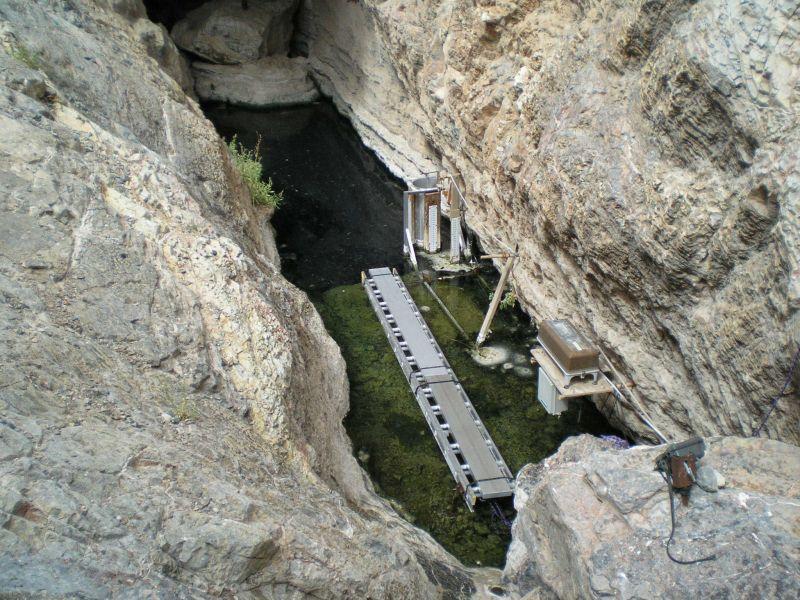
This shot pulled from a security camera video shows three men walking around the Devils Hole unit of Death Valley National Park/NPS
In a bid to arrest those responsible for vandalizing a warm spring with an endangered fish species, Death Valley National Park officials on Monday released a short video showing three men riding up to the Devils Hole unit of the park in an off-road vehicle and roaming around the grounds. Part of the video is from a camera in the warm spring itself. That segment shows one of the men in the water.
At least one pupfish was killed in the incident.
"At around 7:20 p.m. on Saturday, April 30, three men in an OHV drove off-road around a gate at the Devils Hole parking lot. They discharged a firearm at least 10 times, shooting locks on two gates, a motion sensor on the security system, and several signs," a park release issued Monday read. "One man swam in Devils Hole and left his boxer shorts behind in the water. Alcohol was involved; three beer cans were left behind and one man vomited.
"The OHV appeared to be a blue Yahama Rhino, which had been extensively customized with an added seat and safety cage," the release added. "A reward of up to $5,000 is available for information leading to arrest and conviction in this case."
Tips can be reported to the National Park Service's Investigative Services Branch at:
888-653-0009
https:www.surveymonkey.com/r/TipLine_InvestigativeServicesNPS
www.facebook.com/InvestigativeServicesNPS
The Devils Hole pupfish is something of an aquatic wonder, managing to live in a relatively small hot spring, one that denies them the ability to migrate up or down stream. Rather, they congregate in the spring, rising up to a small shelf of rock just beneath the water's surface both to feed and breed. While 40 acres around the spring, which isn't actually within the formal borders of Death Valley National Park but rather off to the east, were set aside in 1952 to protect the hot spring and its inhabitants, a fight over groundwater led to a 1976 Supreme Court ruling that the Park Service was entitled to a specific water right to maintain the hot spring for the fish.
Devils Hole pupfish populations numbered about 400-500 individuals until the late 1960s, when the water level in the pool dropped in response to pumping of nearby irrigation wells, according to the USGS.
As described in a UC Berkeley news release, the Devils Hole pupfish (Cyprinodon diabolis) is "considered the world's rarest fish, with one of the smallest geographic ranges of any wild vertebrate..."

This is a shot of the warm springs at Devils Hole/NPS



Comments
Your comment is ridiculous!
RMW3RD--
I'm a not-so-privileged researcher. Even though I work as a scientist for NPS, I can't just go there to see the Devil's Hole pupfish. An academic I know who works on pupfish and mosquitofish in the Great Basin can't go there, either. There are places I can't go to see grizzly bears. There are lots of caves off limits to everyone. If I want to do any research in a park, I have to go through the same research permit process as anyone else, and try to convince the park superintendent & chief of natural resources to approve my permit.
Devil's Hole isn't a zoo with fish on display. If you want to see Devil's Hole pupfish, I suggest UNLV, perhaps UN-Reno, or U New Mexico. That's where I'd have to go to see live pupfish (albeit in artificial ponds). If your argument is that "enjoyment" in the organic act means seeing the pupfish, I (respectfully) disagree. Many folks "enjoy" just knowing of the continued existence of the pupfish. And if the population is sustained, perhaps the local folks can install a "pupfish-cam" so we can watch them live (from research movies I've seen, the courtship/mating is worth watching) without impacting their tiny habitat.
ec--
Thanks! Cool video. My guess is that the orientation and frequency of the shake sloshed the water in the (open) hole.
All those steps & catwaks are to keep the researchers out of the water: sunscreen & even your natural body oils can affect the water in the pool. [I've done work in tenajas or other temporary rock pools like around Arches & Canyonlands, where the effect on WC can be even more pronounced.] The suspended tubes are various "sondes" measuring water temperature, pH, probably dissolved oxygen, alkalinity, maybe turbidity. I didn't see the pressure transducer for depth in that video. I'm glad I didn't have to write the permit application for all that stuff!
Go to Death Valley some spring: I think you'll like it (avoid Easter week & spring breaks). But at least the last time I was there, no one could go to Ash Meadows FWS refuge or to Devil's Hole itself.
For those who don't know this yet, the 3 men in the video have been identified. According to a story in the Las Vegas Review Register, hey have not been arrested or charged yet, but that seems a formality. I hope that, if convicted, they are dealt with harshly to deter others who might have similar thoughts.
And, felony charges have been filed.
https://www.buzzfeed.com/jimdalrympleii/rip-pupfish?bffbnews&utm_term=.s...